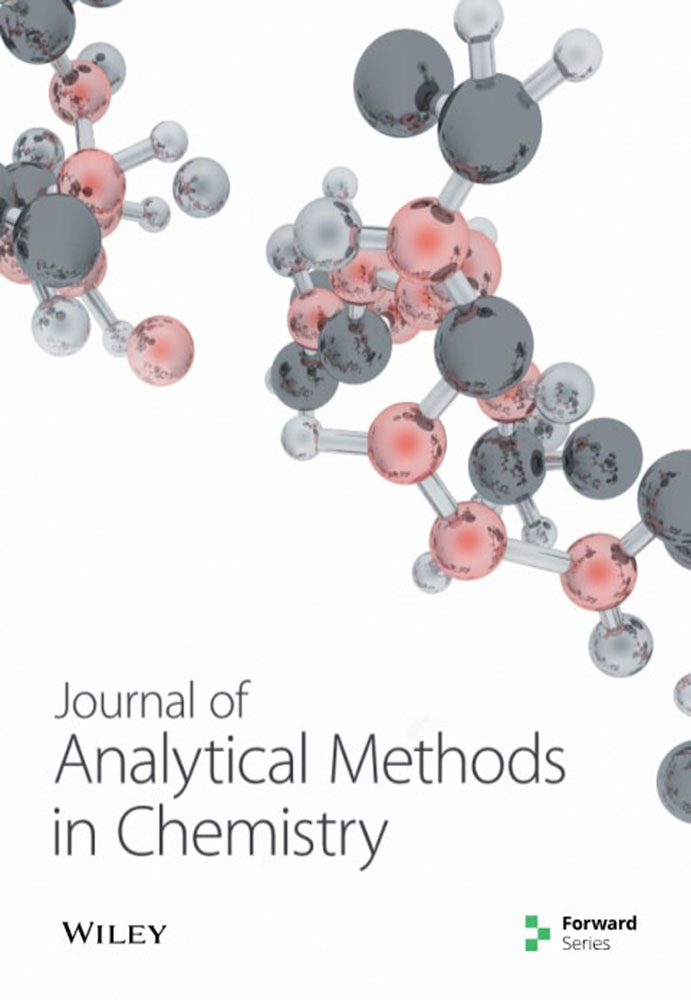同时测定埃塞俄比亚南部 M. stenopetala 中的矿物营养元素和有毒金属:使用 MP-AES 对三个种植区进行比较研究
IF 2.2
3区 化学
Q3 CHEMISTRY, ANALYTICAL
引用次数: 0
摘要
本研究首次使用微波等离子体原子发射光谱(MP-AES)同时测定了辣木(Moringa stenopetala)叶片、种子和支持土壤中十三种微量和宏量营养元素的含量。样品是在 2019 年干旱季节从埃塞俄比亚南部的三个主要莫瑞达(M. stenopetala)种植区(Chano Mile Kebele、Nechisar Kebele 和 Konso Special Woreda)采集的。针对叶片和种子样品开发了一种新的消化方法,使用优化的酸混合物(2.5 : 0.75 : 0.5 的 HNO3、HClO4 和 H2O2),在 240°C 下消化 2 小时 30 分钟,得到无色透明的溶液。该方法最大限度地减少了试剂用量,降低了消化温度,缩短了消化时间,简化了整个过程,从而提高了消化过程的效率。通过加标实验验证了优化程序的效率,回收率在 94% 至 110% 之间。在优化的实验条件下,三个地区的植物叶片和种子样本中的必需矿物质(K、Na、Ca 和 Mg)浓度较高。此外,还发现了大量的微量元素(铁、锰、锌和铜)。重要的是,在所有分析样本中都没有检测到有毒元素(镉和铅)的踪迹,这表明矢车菊的叶子和种子是微量和大量矿物质营养的重要来源,并且不会受到有毒金属的影响。从饮食的角度来看,种子所含矿物质的浓度几乎与叶子相当。因此,矢车菊种子可作为矿物质的替代来源,在克服当前全球粮食危机方面发挥作用,尤其是在旱季。在 95% 的置信水平下进行的方差分析显示,除 K、Ca、Co 和 Cu 外,三个样本平均值之间的所有矿物质养分水平均存在显著差异。总体而言,所开发的方法包括一个创新的消化程序,该程序可最大限度地减少试剂消耗,在较低温度下操作,并需要较短的消化时间,从而优化了资源利用率并保持了分析的准确性。值得注意的是,MP-AES 程序中不存在有毒元素,这凸显了石蒜叶和种子作为重要的、无污染的必需营养素来源的安全性和可靠性。本文章由计算机程序翻译,如有差异,请以英文原文为准。
Simultaneous Determination of Mineral Nutrients and Toxic Metals in M. stenopetala from Southern Ethiopia: A Comparative Study of Three Cultivating Areas Using MP-AES
In this study, for the first time, the levels of thirteen micro- and macromineral nutrients in the leaves, seeds, and supportive soil of Moringa stenopetala (M. stenopetala) were simultaneously determined using microwave plasma atomic emission spectroscopy (MP-AES). The samples were collected during the arid season, in 2019 from the three main M. stenopetala growing areas in southern Ethiopia (Chano Mile Kebele, Nechisar Kebele, and Konso Special Woreda). A novel digestion method for leaf and seed samples was developed using an optimized acid mixture (2.5 : 0.75 : 0.5 of HNO3, HClO4, and H2O2) at 240°C for 2 hrs and 30 min, resulting in clear and colorless solutions. The method makes the digestion process more efficient by minimizing the reagent volume, reducing digestion temperature and time, and simplifying the overall procedure. The efficiency of the optimized procedure was validated by spiking experiments, and the percentage recovery ranged between 94 and 110%. Under optimized experimental conditions, higher concentrations of essential minerals (K, Na, Ca, and Mg) were observed in the plant leaf and seed samples from the three areas. In addition, significant amounts of trace elements (Fe, Mn, Zn, and Cu) were also found. Importantly, no traces of the toxic elements (Cd and Pb) were detected in any of the analyzed samples, suggesting that the leaves and seeds of M. stenopetala are valuable sources of both micro- and macromineral nutrients and are safe from toxic metals. From a dietary perspective, the seed contains almost comparable concentrations of minerals as the leaves. As a result, the seeds of M. stenopetala can serve as an alternative source of minerals and play a role in overcoming the current global food crisis, particularly in the dry season. Analysis of variance at a 95% confidence level revealed significant differences in the levels of all mineral nutrients between the three sample means except K, Ca, Co, and Cu. Generally, the developed method includes an innovative digestion procedure that minimizes reagent consumption, operates at lower temperatures, and requires shorter digestion times, thereby optimizing resource utilization and maintaining analytical accuracy. Notably, the absence of toxic elements in the MP-AES procedure highlights the safety and reliability of M. stenopetala leaves and seeds as valuable, contamination-free sources of essential nutrients.
求助全文
通过发布文献求助,成功后即可免费获取论文全文。
去求助
来源期刊

Journal of Analytical Methods in Chemistry
CHEMISTRY, ANALYTICAL-ENGINEERING, CIVIL
CiteScore
4.80
自引率
3.80%
发文量
79
审稿时长
6-12 weeks
期刊介绍:
Journal of Analytical Methods in Chemistry publishes papers reporting methods and instrumentation for chemical analysis, and their application to real-world problems. Articles may be either practical or theoretical.
Subject areas include (but are by no means limited to):
Separation
Spectroscopy
Mass spectrometry
Chromatography
Analytical Sample Preparation
Electrochemical analysis
Hyphenated techniques
Data processing
As well as original research, Journal of Analytical Methods in Chemistry also publishes focused review articles that examine the state of the art, identify emerging trends, and suggest future directions for developing fields.
 求助内容:
求助内容: 应助结果提醒方式:
应助结果提醒方式:


